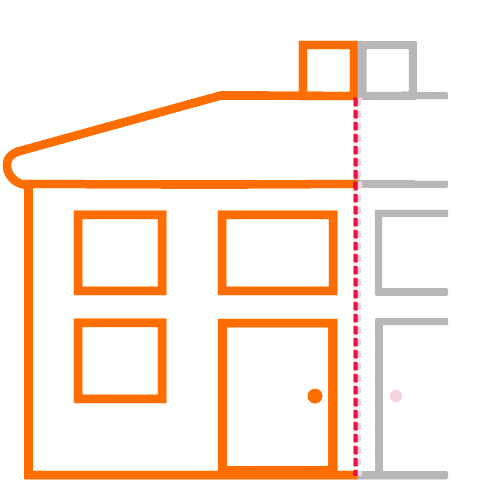Loft insulation makes a significant difference to your home's energy efficiency and comfort levels. You'll notice an immediate reduction in heat loss by over 25%, leading to potential savings of up to £340 annually on your energy bills. With proper installation of materials like mineral wool or PIR boards, you'll reduce your carbon footprint by up to one metric ton of CO2 emissions per year. The installation typically takes only two hours and pays for itself within 10 years through energy savings. Your property value can increase by up to 14% compared to non-insulated homes, making it a smart investment with compelling long-term benefits that extend beyond initial cost savings.
Understanding Heat Loss Through Lofts
Table of Contents
ToggleIn today's energy-conscious world, understanding heat loss through your loft is vital for maintaining an efficient home.
You'll be surprised to learn that your uninsulated loft could be responsible for over a quarter of your home's total heat loss, greatly impacting your energy efficiency and heating costs.
When you're considering loft insulation, it's important to understand that thickness matters greatly.
While you might think a 200mm layer of insulation would suffice, it actually falls short of ideal performance.
The recommended thickness for mineral wool insulation is 270mm, which will help you achieve maximum thermal efficiency.
This proper insulation thickness doesn't just keep your home warmer; it's also making a considerable environmental impact.
You'll be reducing your home's carbon footprint by up to 1 ton of CO2 emissions annually if you live in a detached property.
Additionally, when your loft is properly insulated, you'll notice that your indoor temperatures remain stable for longer periods, which means your heating system won't need to work as hard.
This reduced strain on your heating system leads to lower energy consumption and, consequently, reduced energy bills.
Energy Bills and Cost Savings
While homeowners often hesitate about the upfront costs, loft insulation proves to be one of the most cost-effective home improvements you can make. If you're living in a detached house, you'll see significant returns on your investment, with potential savings of up to £340 per year on your energy bills.
When you consider that uninsulated lofts are responsible for more than 25% of a home's heat loss, it's clear why these savings are so substantial.
You'll find that the financial benefits of loft insulation extend well beyond the initial investment period. With a typical payback timeframe of less than 10 years, you're looking at decades of reduced energy costs once you've recovered the installation expenses.
The enhanced thermal efficiency means you won't need to rely as heavily on your heating system, which directly translates to lower monthly bills. Additionally, you might be eligible for government grants that can help offset the initial installation costs, making the investment even more appealing.
When you factor in the long-term savings and potential financial assistance, loft insulation becomes a compelling solution for managing your home's energy expenses.
Environmental Benefits
Beyond saving money on energy bills, loft insulation delivers substantial environmental benefits that help combat climate change. You'll make a significant impact on reducing carbon emissions, as proper loft insulation can cut CO2 emissions by up to one metric ton annually in detached properties. This reduction plays a crucial role in your home's overall environmental footprint, particularly when you consider that uninsulated lofts are responsible for more than 25% of a home's heat loss.
You're not just improving your home's thermal efficiency when you install loft insulation; you're actively participating in climate change mitigation by reducing unnecessary energy waste.
When you choose sustainable insulation materials like sheep wool or cork, you'll enhance these environmental benefits even further. These eco-friendly options provide excellent insulation while minimizing their environmental impact during production and disposal.
Additionally, you'll be helping to meet modern energy regulations, which are designed to create more sustainable living environments. By preventing heat from escaping through your loft, you're contributing to a broader effort to reduce greenhouse gas emissions and promote energy efficiency in residential buildings.
Types of Insulation Materials
Modern loft insulation comes in several effective materials, each offering distinct advantages for your home's thermal performance.
Mineral wool stands as the industry standard, requiring a substantial 270mm thickness to achieve ideal insulation levels, though you'll need at least 200mm to guarantee adequate thermal protection. You'll find this material in most residential installations due to its proven track record and reliable performance.
If you're working with limited space, PIR boards present a compelling alternative. These high-efficiency panels can deliver equivalent insulation properties at reduced thicknesses, making them ideal for lofts where space constraints are a concern.
For environmentally conscious homeowners, sheep wool insulation offers a sustainable choice that doesn't compromise on performance. This natural material combines effective thermal properties with eco-friendly credentials, though you'll need to evaluate its specific installation requirements.
When you're selecting your insulation material, it's essential to evaluate the relationship between thickness and thermal efficiency.
Your choice will directly impact your home's heat retention capabilities, and opting for materials that meet or exceed recommended thickness specifications will guarantee you achieve maximum energy efficiency benefits.
Installation Requirements and Process
Once you've selected your ideal insulation material, you'll need to focus on proper installation to maximize its effectiveness. The process typically begins with a thorough assessment of your loft space, where professionals evaluate the specific requirements and potential challenges of your installation project.
While you might be tempted to tackle installation as a DIY project, professional installation often proves more beneficial for achieving peak performance. The good news is that a typical installation only takes around two hours, making it a relatively quick home improvement project that won't greatly disrupt your daily routine.
You'll want to obtain multiple quotes from qualified installers, which will help you compare prices and service offerings to find the most suitable option for your needs. During installation, professionals will guarantee proper coverage and ventilation, addressing any existing issues that could impact the insulation's effectiveness.
Once completed, you'll have the flexibility to transform your newly insulated loft into additional living space or storage area, effectively maximizing your home's square footage without requiring structural modifications. This versatility adds substantial value to the installation process beyond just energy efficiency benefits.
Performance and Efficiency Ratings
When evaluating loft insulation's effectiveness, the numbers speak volumes about its performance capabilities. You'll find that proper loft insulation can reduce your home's heat loss by more than 25%, making it one of the most impactful energy-saving improvements you can make to your property.
The performance ratings clearly show that mineral wool insulation reaches its ideal efficiency at 270mm thickness, with minimal gains beyond this point.
You'll see significant improvements in your home's thermal efficiency ratings once you've installed proper loft insulation. If you're living in a detached house, you can expect to save up to £340 on your annual energy bills, demonstrating the substantial impact on both performance and cost-effectiveness.
When you're considering different materials, PIR boards offer an interesting alternative, as they'll achieve similar efficiency ratings at reduced thickness levels.
Your heating system will also operate more efficiently with proper insulation, as it won't need to work as hard to maintain comfortable temperatures. This enhanced performance contributes to better energy ratings for your property, while ensuring that the heat you're paying for stays where it should – inside your home.
Space Utilization and Storage
Installing loft insulation not only improves your home's thermal efficiency but also creates valuable opportunities for space utilization. With proper installation supporting up to 270mm of insulation thickness, you'll still have sufficient space to transform your loft into a functional area while maintaining peak thermal performance.
You can maximize your home's potential by converting your insulated loft into additional living space or a well-organized storage area. The improved temperature regulation makes it particularly suitable for storing items that are sensitive to temperature fluctuations, while the consistent indoor climate creates comfortable conditions for occasional use as a home office or recreational space.
If you're looking to declutter your main living areas, you'll find that your insulated loft provides an excellent solution for organizing household items without compromising on thermal efficiency.
The dual benefits of thermal performance and space enhancement mean you won't have to choose between energy efficiency and practical storage solutions. By investing in proper loft insulation, you're effectively creating a versatile space that can adapt to your changing needs, whether that's additional storage capacity or a comfortable area for various activities.
Grants and Financial Support
While maximizing your loft space offers practical benefits, the financial aspects of insulation can be even more appealing.
You'll find that numerous grant opportunities are available in the UK to help offset the initial installation costs, making loft insulation a more accessible home improvement option. The Energy Company Obligation (ECO) scheme, in particular, provides substantial support for low-income households looking to enhance their home's energy efficiency.
You'll want to explore the various funding sources available through both local authorities and environmental organizations, as these can greatly reduce your upfront expenses.
The grants often cover a considerable portion of the installation costs, which means you'll typically recover your investment within just a few years through reduced energy bills.
To maximize your chances of securing financial support, it's essential that you check with your local council and energy providers about specific grant opportunities.
They'll help you understand the eligibility criteria and guide you through the application process.
When you combine these financial incentives with the long-term energy savings, you'll find that loft insulation becomes a highly cost-effective home improvement investment.
Long-Term Property Value Benefits
The long-term value of your property stands to gain considerably from proper loft insulation. Research shows that energy-efficient homes can command up to 14% higher selling prices compared to similar properties without such improvements, making loft insulation a smart investment for your future.
When you're planning to sell your home, you'll find that buyers are increasingly prioritizing energy-efficient features in their property searches. Your loft insulation becomes a significant selling point, particularly when you can demonstrate annual energy savings of up to £340. This tangible benefit makes your property more attractive in a competitive market, where energy costs and environmental considerations continue to influence buying decisions.
You'll also benefit from improved compliance with current energy regulations, which is becoming increasingly important in property transactions. By maintaining proper loft insulation, you're not just reducing your immediate energy costs; you're making a strategic investment that'll pay dividends when it's time to sell.
The combination of lower operating costs, enhanced comfort, and improved energy efficiency ratings creates a compelling package that helps maintain and potentially increase your property's market value over time.





